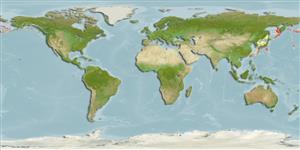>
Perciformes/Cottoidei (Sculpins) >
Liparidae (Snailfishes)
Etymology: Careproctus: Greek, kara = face + Greek, proktos = anus (Ref. 45335); lycopersicus: Named for the tomato plant, Solanum lycopersicum, meaning ‘wolf peach'; referring to its typically bright red tomato-like coloration..
Environment: milieu / climate zone / depth range / distribution range
Ecologia
marinhas batidemersal; intervalo de profundidade 397 - 1157 m (Ref. 91047). Temperate
North Pacific: Bering Sea and the eastern Aleutian Islands.
Tamanho / Peso / Idade
Maturity: Lm ? range ? - ? cm
Max length : 13.3 cm TL macho/indeterminado; (Ref. 91047); 17.2 cm TL (female)
Descrição suscinta
Morfologia | Morfometria
Raios dorsais (total): 42-45; Raios anais : 34 - 38; Vértebras: 45 - 50. This species is distinguished from its congeners by the following characters: premaxilla and dentary with broad rows of strongly trilobed teeth (vs. simple or weakly trilobed teeth on both jaws); the large gill opening extends ventrally to pectoral rays 8-12 (vs. smaller above the pectoral fin or extending to less than five pectoral-fin rays); large pelvic disk greater or equal 30% head length (vs. smaller pelvic disk, < 25% HL); most similar to C. ovigerus, which can be distinguished from C. lycopersicus by its simple, canine teeth on both jaws, and to C. kamikawai, which is distinguished by its subterminal mouth, slight dorsal-fin lobe, black peritoneum, smaller pelvic disc, slender caudal base, and more anterior position of the pelvic disc, anus, and anal-fin origin (Ref. 91047).
One 11.6 cm TL ripe male and female specimens were examined: the smallest female with yolked eggs was 14.9 cm (UW 119817). For the ripe females, at least two sizes of eggs were present, yolked eggs were 3.5 mm in diameter and smaller white eggs had diameters of 0.5-1.5 mm (Ref. 91047).
Ciclo de vida ou comportamento de acasalamento
Maturidade | Reprodução | Desova | Ovos | Fecundidade | Larvas
Orr, J.W., 2012. Two new species of snailfishes of the genus Careproctus (Scorpaeniformes: Liparidae) from the Bering Sea and Eastern North Pacific Ocean, with a redescription of Careproctus ovigerus. Copeia 2012(2):257-265. (Ref. 91047)
Status na Lista Vermelha da UICN (Ref. 130435)
Ameaça para os humanos
Harmless
Uso pelos humanos
Mais informação
Nomes comunsSinônimosMetabolismoPredadoresEcotoxicologiaReproduçãoMaturidadeDesovaAgregação de desovaFecundidadeOvosDesenvolvimento dos ovos
Idade/TamanhoCrescimentoPeso-comprimentoComprimento-comprimentoFrequências de comprimentoMorfometriaMorfologiaLarvasDinâmica larvalRecrutamentoAbundânciaBRUVS
ReferênciasAquaculturaPerfil para aquaculturaEstirpesGenéticaElectrophoresesHereditariedadeDoençasProcessamentoNutrientsConversão de massa
ColaboradoresFotosStamps, Coins Misc.SonsCiguateraVelocidadeTipo de nataçãoÁrea branquialOtólitosCérebrosVisão
Ferramentas
Relatórios especiais
Baixar XML
Fontes da internet
Estimates based on models
Preferred temperature (Ref.
123201): 2 - 3.5, mean 3.3 °C (based on 22 cells).
Índice de diversidade filogenética (Ref.
82804): PD
50 = 0.5000 [Uniqueness, from 0.5 = low to 2.0 = high].
Bayesian length-weight: a=0.00447 (0.00204 - 0.00980), b=3.17 (2.99 - 3.35), in cm total length, based on LWR estimates for this Genus-body shape (Ref.
93245).
Nível Trófico (Ref.
69278): 3.2 ±0.5 se; based on size and trophs of closest relatives
Resiliência (Ref.
120179): Elevada, tempo mínimo de duplicação da população menor que 15 meses (Preliminary K or Fecundity.).
Fishing Vulnerability (Ref.
59153): Low vulnerability (10 of 100).
